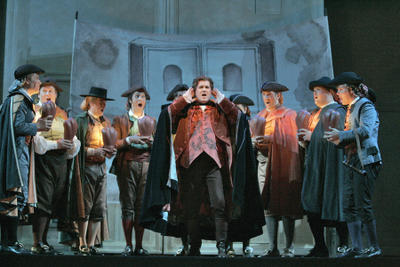I did not mention Rossini's The Barber of Seville here in Santa Fe on my list of Opera in the Summer 2005. This is not because I don't like Barber of Seville: I like it just fine. Still, I would not myself travel across the country only to hear it, no matter how good the production, and I would not advise any one to do so. It's a standard, it has limitless appeal when done well, and it's great for neophytes. For me, and this is a matter of personal taste, more daring programming is always better. This is one of the reasons why I didn't put anything at Glimmerglass Opera on my list this year. Nothing turned my crank. (Looking at their schedule again, this is not really fair. I would go up there to see Poulenc's La Voix Humaine or Britten's Death in Venice, which opens tonight.) That being said, seeing a new production of something you know quite well can be a lot of fun, especially if the director has ideas about the work that you might not expect.
 That was not the case with this Barber of Seville. The set (Riccardo Hernandez) and costumes (Anna Marie Heinreich), although beautifully made, were fairly traditional. The director introduced some innovations, such as the two acrobats (members of a troupe called Wise Fool New Mexico) representing Figaro and Almaviva, who climbed a ladder stretching from floor to ceiling. During a brief orchestral interlude in Act II, we were treated to their climbing and nearly falling from that ladder, which added some interest. Musicians climbed from the pit on a ladder to take their places onstage for Almaviva’s opening serenade, including the harpsichord player, who remained there to play for the recitativo secco. (Although the concept of the continuo player interacting with the characters is funny, it went too far.) The direction emphasized slapstick and overdone mugging, which fits perfectly with the opera's genre but wore thin by the end. By and large, this production was your father's Barber of Seville.
That was not the case with this Barber of Seville. The set (Riccardo Hernandez) and costumes (Anna Marie Heinreich), although beautifully made, were fairly traditional. The director introduced some innovations, such as the two acrobats (members of a troupe called Wise Fool New Mexico) representing Figaro and Almaviva, who climbed a ladder stretching from floor to ceiling. During a brief orchestral interlude in Act II, we were treated to their climbing and nearly falling from that ladder, which added some interest. Musicians climbed from the pit on a ladder to take their places onstage for Almaviva’s opening serenade, including the harpsichord player, who remained there to play for the recitativo secco. (Although the concept of the continuo player interacting with the characters is funny, it went too far.) The direction emphasized slapstick and overdone mugging, which fits perfectly with the opera's genre but wore thin by the end. By and large, this production was your father's Barber of Seville.Margaret M. Barela, Nothing's shaved in this stylish, comedic opera (Albuquerque Tribune, July 15) |
It was a very good cast, all in all, with great contributions from the male chorus, in hilarious turns as the rowdy serenading musicians and the police force. What I especially appreciated was the improvisational approach of singers and even the continuo player to the score, meaning that ornaments, cadenzas, spontaneous flourishes (like the continuo's reference to Figaro's first great aria at the character's later entrance) were added, making this rendition individually interesting. Conductor Kenneth Montgomery led an excellent orchestra, proving itself limber and accurate from the first notes of the opera's famous overture. The piccolo player (or players? three are listed in the program) was especially fine. It would have been a great evening to take an opera neophyte to, and I enjoyed it a lot, even if I found my mind distractedly looking forward to a more interesting evening tonight, with Britten's Peter Grimes.
No comments:
Post a Comment